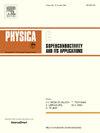Planckian dissipation and c-axis superfluid density in cuprate superconductors
IF 1
3区 物理与天体物理
Q4 PHYSICS, APPLIED
Physica C-superconductivity and Its Applications
Pub Date : 2025-05-20
DOI:10.1016/j.physc.2025.1354735
引用次数: 0
Abstract
An interesting concept in condensed matter physics is Planckian dissipation, in particular its manifestation in a remarkable phenomenology of superfluid density as a function of superconducting transition temperatures of cuprate high-temperature superconductors. The concept was introduced for -plane properties. However, here I show that when suitably interpreted, it is also applicable to the -axis resistivity, which has not been adequately addressed previously. There are two results in this note: the first is a derivation using Kubo formula as to how Planckian dissipation could arise. It is aided by the fact that the -axis tunneling matrix element is small enough such that a second order perturbation theory combined with presumed non-Fermi liquid behavior is sufficient to illuminate the phenomenon. In addition, the notion of quantum criticality plays an important role.
铜超导体中的普朗克耗散和c轴超流体密度
凝聚态物理中一个有趣的概念是普朗克耗散,特别是它在铜高温超导体超导转变温度函数的超流体密度显着现象学中的表现。引入了ab平面性质的概念。然而,在这里我表明,当适当解释时,它也适用于c轴电阻率,这在以前没有得到充分解决。这篇笔记有两个结果:第一个是用久保公式推导出普朗克耗散如何产生。c轴隧穿矩阵元素足够小,因此二阶微扰理论结合假定的非费米液体行为足以阐明这一现象。此外,量子临界的概念也起着重要的作用。
本文章由计算机程序翻译,如有差异,请以英文原文为准。
求助全文
约1分钟内获得全文
求助全文
来源期刊
CiteScore
2.70
自引率
11.80%
发文量
102
审稿时长
66 days
期刊介绍:
Physica C (Superconductivity and its Applications) publishes peer-reviewed papers on novel developments in the field of superconductivity. Topics include discovery of new superconducting materials and elucidation of their mechanisms, physics of vortex matter, enhancement of critical properties of superconductors, identification of novel properties and processing methods that improve their performance and promote new routes to applications of superconductivity.
The main goal of the journal is to publish:
1. Papers that substantially increase the understanding of the fundamental aspects and mechanisms of superconductivity and vortex matter through theoretical and experimental methods.
2. Papers that report on novel physical properties and processing of materials that substantially enhance their critical performance.
3. Papers that promote new or improved routes to applications of superconductivity and/or superconducting materials, and proof-of-concept novel proto-type superconducting devices.
The editors of the journal will select papers that are well written and based on thorough research that provide truly novel insights.

 求助内容:
求助内容: 应助结果提醒方式:
应助结果提醒方式:


